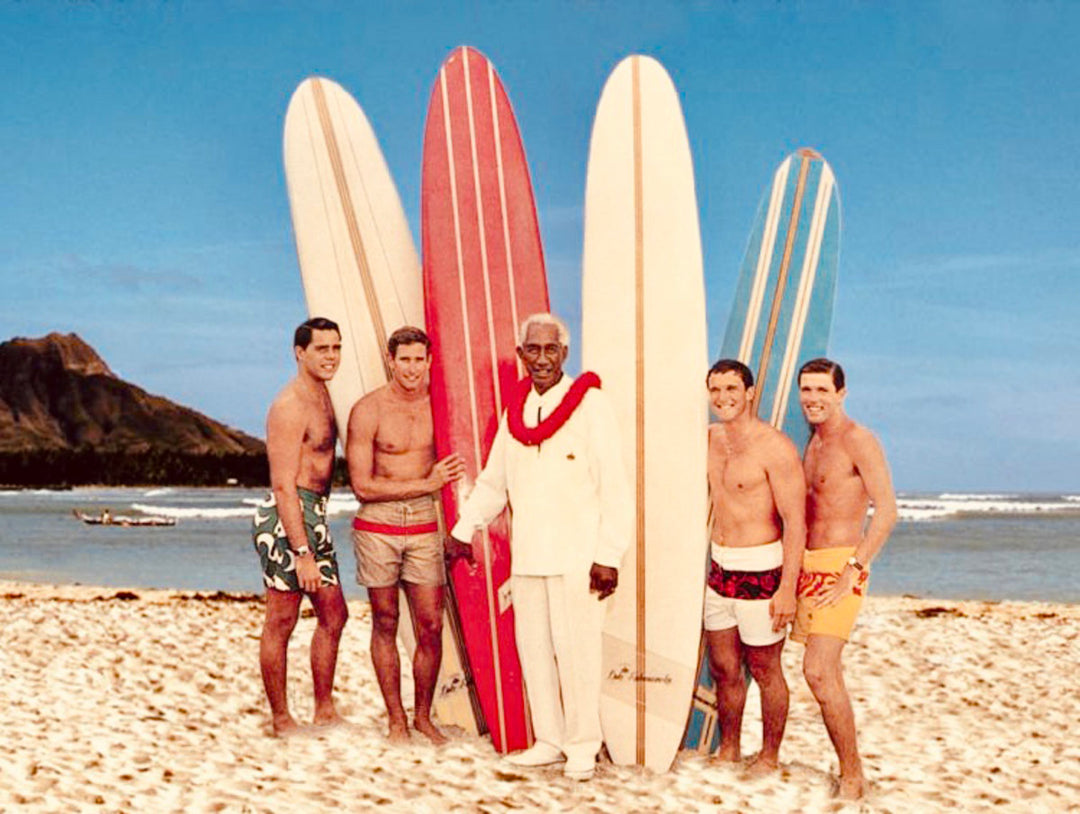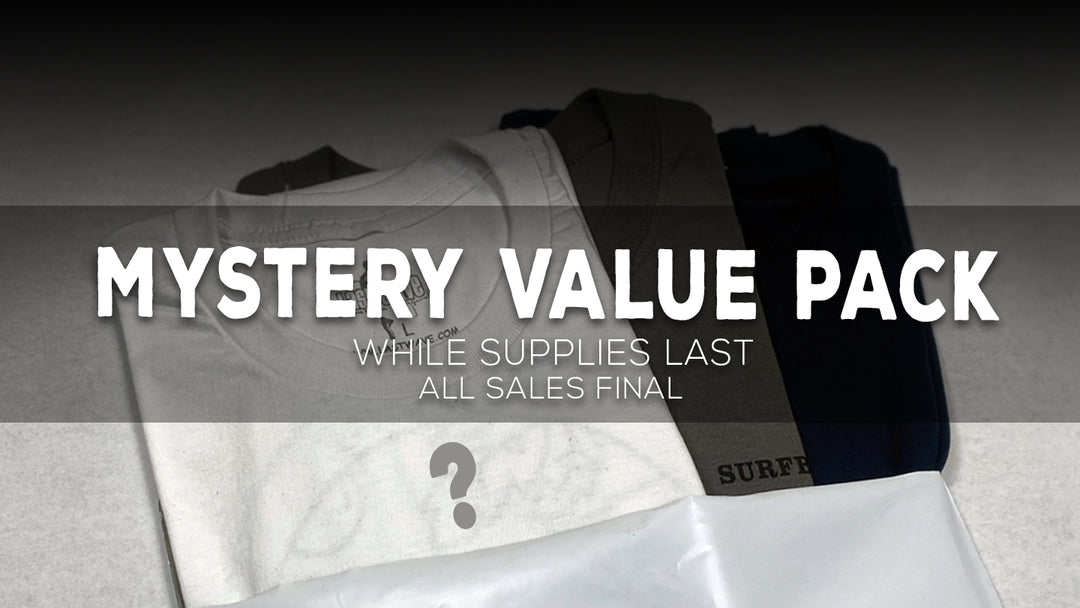Since we’re adding a couple of cool new color options and a long sleeve to Last Wave’s Sex Wax t-shirt offerings, it seems like a good time to talk about surf wax…an essential yet mostly unheeded surfing accessory. Like just about everything else in surf history, it has an interesting history behind it and involves a host of colorful characters.
 Going back to the first few decades of the 20th century, surfers would often coat the decks of their wooden boards with sand-infused varnish for traction. It worked, but inevitably led to uncomfortable abrasions to the feet, knees and chests. Remember what those canvas surf mats you rented as a kid did to your skin? Varnish with some sand mixed in had to have been waaaay worse!
Going back to the first few decades of the 20th century, surfers would often coat the decks of their wooden boards with sand-infused varnish for traction. It worked, but inevitably led to uncomfortable abrasions to the feet, knees and chests. Remember what those canvas surf mats you rented as a kid did to your skin? Varnish with some sand mixed in had to have been waaaay worse!
In 1935, it is said that a teenager from Palos Verdes, California took his mother’s suggestion and tried applying paraffin wax to his board to make is less slippery. Apparently it worked, because for the next 25 years or so, surfers used paraffin to wax their boards – the same wax commonly used in the kitchen for sealing jars of homemade jams and jellies. I remember going the grocery store with my brother to buy Parowax…it came in a box of 4, 4-ounce bars and cost something like 30 cents. We would melt a bar or two in an old juice can and roll up a sheet of newspaper. We’d dip the rolled newspaper in the melted Parowax and drip it onto the board to make the bumps. By the way, if for some reason you wanted to re-wax your board with good old Parowax today, you could; but that same 1-pound box would cost you $9.86 on Amazon!
 In the late ‘60s, Rusty Miller and the late Mike Doyle jumped into the emerging surf wax business with a product called Waxmate. Its base was paraffin, with motor oil (of all things) added to soften the wax. Since it was much more expensive than Parowax, it took a few years for Waxmate to gain traction in the marketplace. Then in 1972, a guy named John Dahl started a company called Wax Research in Encinitas, California.
In the late ‘60s, Rusty Miller and the late Mike Doyle jumped into the emerging surf wax business with a product called Waxmate. Its base was paraffin, with motor oil (of all things) added to soften the wax. Since it was much more expensive than Parowax, it took a few years for Waxmate to gain traction in the marketplace. Then in 1972, a guy named John Dahl started a company called Wax Research in Encinitas, California.During the same year and just a few hours up the California coast in Carpinteria, Rick Herzog began producing and marketing a new brand of surf wax. Rick – widely known as “
Mr. Zog” – turned to his good friend Hank Pitcher to come up with a catchy name for his new product line. In a matter of just a few days, Hank had it – Sex Wax. At first,
Zog thought the name was a bit strange and perhaps too controversial, but after some consideration, he decided that “being outrageous would be fun and consistent with my sarcastic nature.” The name stuck.
 By the early ‘80s, Sex Wax was competing with a dozen or so young surf wax companies, including Waxx On (Southern California) and Mrs. Palmer’s (Australia). Then in the late ‘80s and into the early ‘90s, the growing popularity of tail pads and full deck traction pads worried surf wax manufacturers. A few – like Sex Wax - responded by improving and diversifying their products with a variety of complicated formulas for different water temperatures, tackiness, etc.
By the early ‘80s, Sex Wax was competing with a dozen or so young surf wax companies, including Waxx On (Southern California) and Mrs. Palmer’s (Australia). Then in the late ‘80s and into the early ‘90s, the growing popularity of tail pads and full deck traction pads worried surf wax manufacturers. A few – like Sex Wax - responded by improving and diversifying their products with a variety of complicated formulas for different water temperatures, tackiness, etc.
Today,
Mr. Zog’s Sex Wax has to be the most recognizable name in surf wax. The company produces millions of bars of its scented wax each year, as well as wax remover, candles, towels, rash guards and of course a line of cool Sex Wax apparel. What started out as a part-time gig for Rick Herzog in 1972 (he’d been shaping and glassing Zog Surfboards from his Santa Barbara shop since ‘69) has grown into a very successful surf business. As Mr. Zog himself has said, “I am proud of both the quality of the surfboard wax we have produced over the years and the success of the Sex Wax brand name. It’s reached an amazing level of recognition.” Zog admits that the edgy nature of the Sex Wax name may limit its overall share of the
surf apparel market, but he still thinks it’s a good fit for the psyche of most surfers. We at Last Wave think so too…
Until next time,
Ted

 Going back to the first few decades of the 20th century, surfers would often coat the decks of their wooden boards with sand-infused varnish for traction. It worked, but inevitably led to uncomfortable abrasions to the feet, knees and chests. Remember what those canvas surf mats you rented as a kid did to your skin? Varnish with some sand mixed in had to have been waaaay worse!
Going back to the first few decades of the 20th century, surfers would often coat the decks of their wooden boards with sand-infused varnish for traction. It worked, but inevitably led to uncomfortable abrasions to the feet, knees and chests. Remember what those canvas surf mats you rented as a kid did to your skin? Varnish with some sand mixed in had to have been waaaay worse!
 In the late ‘60s, Rusty Miller and the late Mike Doyle jumped into the emerging surf wax business with a product called Waxmate. Its base was paraffin, with motor oil (of all things) added to soften the wax. Since it was much more expensive than Parowax, it took a few years for Waxmate to gain traction in the marketplace. Then in 1972, a guy named John Dahl started a company called Wax Research in Encinitas, California.
In the late ‘60s, Rusty Miller and the late Mike Doyle jumped into the emerging surf wax business with a product called Waxmate. Its base was paraffin, with motor oil (of all things) added to soften the wax. Since it was much more expensive than Parowax, it took a few years for Waxmate to gain traction in the marketplace. Then in 1972, a guy named John Dahl started a company called Wax Research in Encinitas, California. By the early ‘80s, Sex Wax was competing with a dozen or so young surf wax companies, including Waxx On (Southern California) and Mrs. Palmer’s (Australia). Then in the late ‘80s and into the early ‘90s, the growing popularity of tail pads and full deck traction pads worried surf wax manufacturers. A few – like Sex Wax - responded by improving and diversifying their products with a variety of complicated formulas for different water temperatures, tackiness, etc.
By the early ‘80s, Sex Wax was competing with a dozen or so young surf wax companies, including Waxx On (Southern California) and Mrs. Palmer’s (Australia). Then in the late ‘80s and into the early ‘90s, the growing popularity of tail pads and full deck traction pads worried surf wax manufacturers. A few – like Sex Wax - responded by improving and diversifying their products with a variety of complicated formulas for different water temperatures, tackiness, etc.








